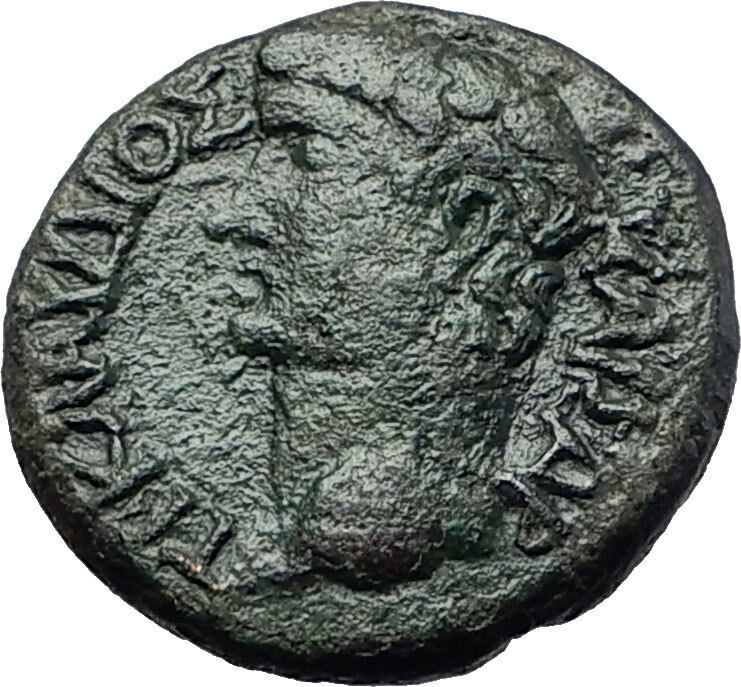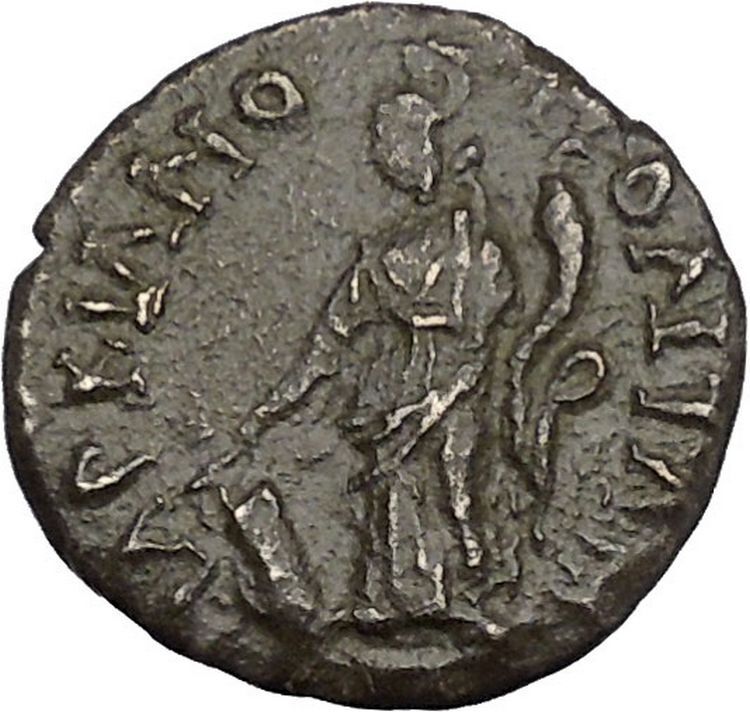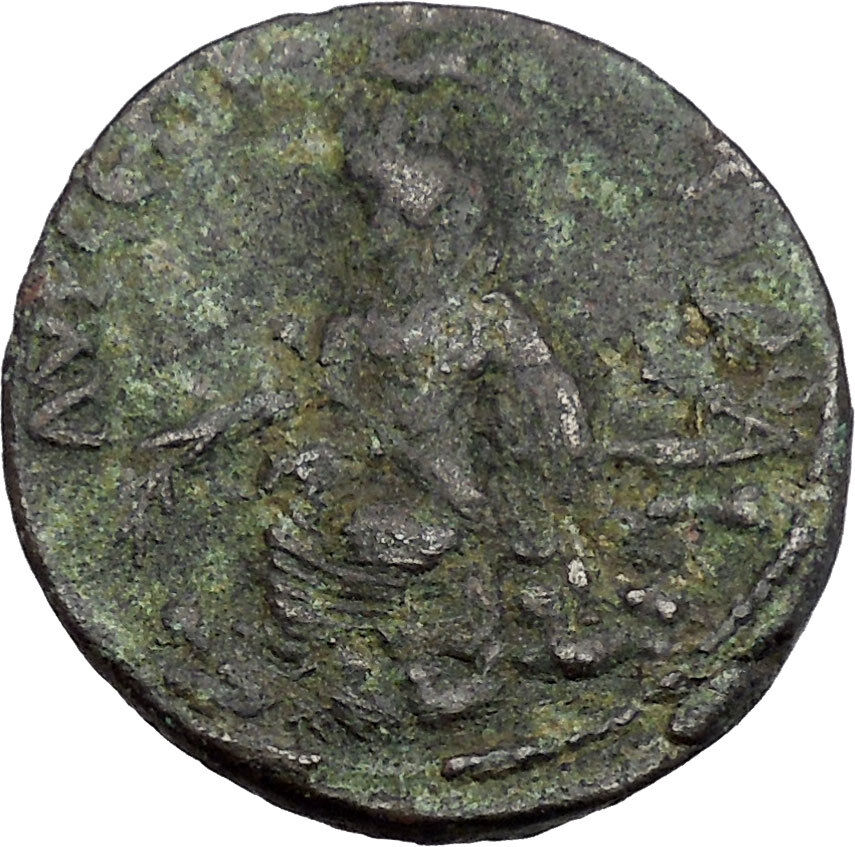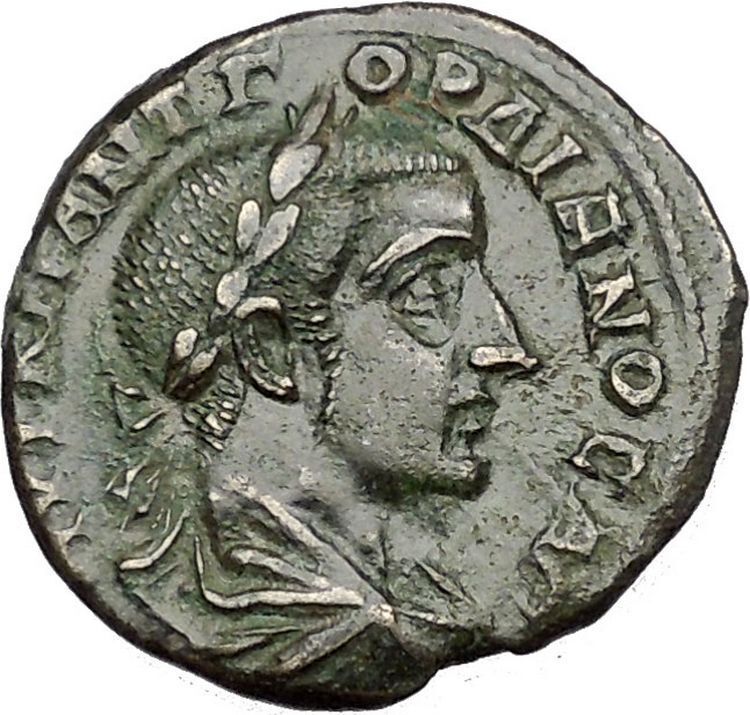|
Gordian III
–
Roman Emperor
: 238-244 A.D. –
Bronze 23mm (11.07 grams) of
Nysa-Scythopolis
(Beth Shean) in
Samaria
Year 304 of the Pompeian Era, 240/241 A.D.
Pedigree: Ex-Lawrence B. Wohl Collection with original hand-written ticket
Reference: Mesh. 110A; Ros. 59; Barkay 90; cf. Spijkerman p. 206, 59
ΑVT. K. M. ANT. ΓΟΡΔΙΑΝΟC CЄ, Laureate, draped and cuirassed bust right.
NVC CKV. Θ ΙΕΡ. A., Dionysos walking right,
holding thyrsos transversely in right hand, thrusting at small figure before
him; on left, panther seated; palm branch in field, date,
ΔΤ in field to right (year 304).
You are bidding on the exact
item pictured, provided with a Certificate of Authenticity and Lifetime
Guarantee of Authenticity.
Dionysus or
Dionysos (Greek
Διόνυσος) is the
ancient Greek
god
of the grape harvest,
winemaking
and
wine, of ritual madness and
ecstasy
, was also the driving force behind
Greek theater
. The god who inspires joyful
worship and
ecstasy
, festivals and celebration is a major
figure of
Greek mythology
and the
religion of ancient Greece
. He is included as
one of the
![2nd century Roman statue of Dionysus, after a Hellenistic model (ex-coll. Cardinal Richelieu, Louvre[1])](https://upload.wikimedia.org/wikipedia/commons/thumb/8/8a/Dionysos_Louvre_Ma87_n2.jpg/200px-Dionysos_Louvre_Ma87_n2.jpg)
twelve
Olympians in some lists. Dionysus is typical of the god of the
epiphany
, “the god that comes”. He was also
known as Bacchus, the name adopted by the
Romans
and the frenzy he induces, bakkheia.
Hailed as an Asiatic foreigner, he was thought to have had strong ties to the
East and to Ethiopia
in the South. He was also known as the
Liberator (Eleutherios),
freeing one from one’s normal self, by madness, ecstasy or wine. The divine
mission of Dionysus was to mingle the music of the
aulos
and to bring an end to care and worry.
Scholars have discussed Dionysus’ relationship to the “cult of the souls” and
his ability to preside over communication between the living and the dead.
In Greek mythology, Dionysus is made out to be a son of
Zeus and the mortal
Semele
. He is described as being womanly or
“man-womanish”. The
retinue
of Dionysus was called the
thiasus
and was composed chiefly of
maenads
and
satyrs
. Dionysus is a god of
mystery religious rites
. In the
Thracian
mysteries, he wears the bassaris
or
fox-skin, symbolizing new life. His own rites, the
Dionysian Mysteries
practiced by
maenads
and others, were the most secret of
all. Many scholars believe that Dionysus is a
syncretism
of a local Greek nature deity and a
more powerful god from
Thrace
or
Phrygia
such as
Sabazios
or
Zalmoxis
.
Contradictions in Dionysus’ origin suggest to some that we are dealing not
with the historical memory of a cult that is foreign, but with a god in whom
foreignness is inherent.
Karl Kerenyi
traces him to
Minoan Crete
, where his Minoan name is unknown
but his characteristic presence is recognizable. Clearly, Dionysus had been with
the Greeks and their predecessors a long time, and yet always retained the feel
of something alien.
About this sound Beit She’an (help·info) (Hebrew: בֵּית
שְׁאָן Beth Šəān; Arabic: بيسان, About this sound Beesān (help·info), Beisan or
Bisan) is a city in the North District of Israel which has played an important
role historically due to its geographical location at the junction of the Jordan
River Valley and Jezreel Valley. It has also played an important role in modern
times, acting as the regional center for the numerous villages in the Beit
She’an Valley Regional Council.
The ancient city ruins are now protected as an Israeli national park, known as
Bet She’an National Park.
History
Beit She’an’s location has often been strategically significant, as it sits
at the junction of the Jordan River Valley and the
Jezreel Valley
, essentially controlling access
from the interior to the coast, as well as from
Jerusalem
to the
Galilee
.
Early Beit She’an
In 1933, archaeologist G.M. FitzGerald, under the auspices of the
University of Pennsylvania Museum
, carried out
a “deep cut” on Tell el-Hisn (“castle hill”), the large mound of Beth She’an, in
order to determine the earliest occupation of the site. His results suggest that
settlement began in the
Late Neolithic
or
Early Chalcolithic
periods (sixth to fifth
millennia BCE.) Occupation continued intermittently up to the late
Early Bronze Age
I (3200-3000), according to
pottery finds, and then resumes in the Early Bronze Age III. A large cemetery on
the northern side of the mound was in use from the Bronze Age to
Byzantine
times.
Canaanite
graves dating from 2000 to 1600 BCE
were discovered in 1926.
Egyptian period

BetShe’an – an ancient house of Egyptian governor
After the
Egyptian
conquest of Beit She’an by pharaoh
Thutmose III
in the 15th century BCE (recorded
in an inscription at
Karnak
), the small town on the summit of the
Tell became the center of the Egyptian administration of the region. The
Egyptian newcomers changed the organization of the town and left a great deal of
material culture behind. A large Canaanite temple (39 meters in length)
excavated by the
University of Pennsylvania Museum
may date from
about the same period as Thutmose III’s conquest, though the Hebrew University
excavations suggest that it dates to a later period. Artifacts of potential
cultic significance were found in the temple. Based on a stele found in the
temple and inscribed with Egyptian hieroglyphs, the temple was dedicated to the
god Mekal. One of the University Museum’s most important finds near the temple
is the
Lion and Dog stela
(currently in the
Israel Museum
in Jerusalem), which depicts two
combat scenes between these two creatures. The
Hebrew University
excavations determined that
this temple was built on the site of an earlier one.
During the three hundred years of Egyptian rule (18th Dynasty to the 20th
Dynasty), the population of Beit She’an appears to have been primarily Egyptian
administrative officials and military personnel. The town was completely
rebuilt, following a new layout, during the 19th dynasty. The University Museum
excavations uncovered two important stelae from the period of
Seti I
and a monument of
Rameses II
. Pottery was produced locally, but
some was made to mimic Egyptian forms. Other Canaanite goods existed alongside
Egyptian imports or locally made Egyptian-style objects. The 20th dynasty saw
the construction of large administrative buildings in Beit She’an, including
Building 1500, a small palace for the Egyptian governor. During the 20th
dynasty, invasions of the “Sea
Peoples” upset Egypt’s control over the Eastern Mediterranean. Though
the exact circumstances are unclear, the entire site of Beit She’an was
destroyed by fire around 1150 BCE. The Egyptians did not attempt to rebuild
their administrative center and lost control of the region.
Biblical period

Map of the
Decapolis
showing the location of
Beit She’an, (here called by its Greek name, Scythopolis)
An Iron Age
I Canaanite city was constructed on
the site of the Egyptian center shortly after its destruction. Around 1100 BC,
Canaanite Beit She’an was conquered by the Philistines, who used it as a base of
operations for further penetrations into Israel proper. During a subsequent
battle against the Jewish King Saul at nearby Mount Gilboa in 1004 BC, the
Philistines prevailed. 1 Samuel 31 states that the victorious Philistines hung
the body of King Saul
on the walls of Beit She’an. Portions of
these walls were excavated on Tel Beit She’an recently. King David was able to
capture Beit Shea’an in a series of brilliant military campaigns that expelled
the Philistines from the area, pushing them back to their coastal strongholds of
Ashkelon, Ekron, Gath, Gaza, and Ashdod.
During the Iron Age II period, the town became a part of the larger Israelite
kingdom under the rule of the Biblical kings
David
and
Solomon
(1 Kings 4:12 refers to Beit She’an as
a part of the district of Solomon, though the historical accuracy of this list
is debated. The Assyrian
conquest of northern Israel under
Tiglath-Pileser III
(732 BCE) brought about the
destruction of Beit She’an by fire. Minimal reoccupation occurred until the
Hellenistic
period.
The
Hellenistic and Roman Periods
The
Hellenistic
period saw the reoccupation of the
site of Beit She’an under the new name Scythopolis (Ancient
Greek: Σκυθόπολις), possibly named after the
Scythian
mercenaries who settled there as
veterans. Little is known about the Hellenistic city, but during the 3rd century
BCE a large temple was constructed on the Tell. It is unknown which deity was
worshipped there, but the temple continued to be used during Roman times. Graves
dating from the Hellenistic period are simple singular rock-cut tombs. From 301
to 198 BCE the area was under the control of the
Ptolemies
, and Beit She’an is mentioned in
3rd–2nd-century BC written sources describing the Syrian Wars between the
Ptolemid and Seleucid dynasties. In 198 BCE the
Seleucids
conquered the region. The town played
a role after the
Hasmonean
Maccabee Revolt:
Josephus
records that the Jewish High Priest
Jonathan was killed there by
Demetrius II Nicator
. The city was destroyed by
fire at the end of the 2nd century BCE.
In 63 BC, Pompey
made Judea a part of the Roman empire.
Beit She’an was refounded and rebuilt by
Gabinius
.[24]
The town center shifted from the summit of the Tel to its slopes. Scythopolis
prospered and became the leading city of the
Decapolis
, a loose confederation of ten cities
that were centers of Greco-Roman culture, an event so significant that the town
based its calendar on that year. The city flourished under the
Pax Romana
, as evidenced by high-level urban
planning and extensive construction, including the best preserved Roman theatre
of ancient Samaria
, as well as a
hippodrome
,
cardo
, and other trademarks of the Roman
influence.
Mount Gilboa
, 7 km (4 mi) away, provided dark
basalt
blocks as well as water via an aqueduct.
The town is said to have sided with the Romans during the Jewish uprising of 66
CE. Excavations have focused less on the Roman period ruins, so less is known
about this period. The University Museum excavation of the northern cemetery,
however, did uncover significant finds. The Roman period tombs are of the
loculus type: a rectangular rock-cut chamber with smaller chambers (loculi)
cut into its side. Bodies were placed in the loculi or inside sarcophagi
which were the placed in the loculi. A sarcophagus with an inscription
identifying its occupant in Greek as “Antiochus, the son of Phallion” may have
held the cousin of
Herod the Great
. One of the most interesting
Roman grave finds was a bronze incense shovel with the handle in the form of an
animal leg and hoof, now in the
University of Pennsylvania Museum
.
Byzantine period
Copious archaeological remains were found dating to the
Byzantine
period (330 CE – 636 CE) and were
excavated by the
University of Pennsylvania Museum
from 1921-23.
A rotunda church was constructed on top of the Tell and the entire city was
enclosed in a wall. Textual sources mention several other churches in the town.
Beit She’an was primarily Christian, as attested to by the large number of
churches, but evidence of Jewish habitation and a Samaritan synagogue indicate
established communities of these minorities. The pagan temple in the city centre
was destroyed, but the
nymphaeum
and Roman baths were restored. Many
of the buildings of Scythopolis were damaged in the Galilee earthquake of 363,
and in 409 it became the capital of the northern district,
Palaestina Secunda
. Dedicatory inscriptions
indicate a preference for donations to religious buildings, and many colourful
mosaics, such as that featuring the zodiac in the Monastery of Lady Mary, or the
one picturing a menorah and shalom in the House of Leontius’ Jewish synagogue,
were preserved. A Samaritan synagogue’s mosaic was unique in abstaining from
human or animal images, instead utilising floral and geometrical motifs.
Elaborate decorations were also found in the settlement’s many luxurious villas,
and in the 6th century especially, the city reached its maximum size of 40,000
and spread beyond its period city walls.
The Byzantine period portion of the northern cemetery was excavated in 1926.
The tombs from this period consisted of small rock-cut halls with vaulted graves
on three sides. A great variety of objects were found in the tombs, including
terracotta figurines possibly depicting the Virgin and Child, many terracotta
lamps, glass mirrors, bells, tools, knives, finger rings, iron keys, glass
beads, bone hairpins, and many other items.
Arab Caliphate period
In 634, Byzantine forces were defeated by the
Muslim army
of
Caliph Umar ibn al-Khattab and the city was renamed Baysan. The day
of victory came to be known in Arabic as Yawm Baysan or “the day of
Baysan.” The city was not damaged and the newly arrived Muslims lived together
with its Christian population until the 8th century, but the city declined
during this period. Structures were built in the streets themselves, narrowing
them to mere alleyways, and makeshift shops were opened among the colonnades.
The city reached a low point by the 8th century, witnessed by the removal of
marble
for producing
lime
, the blocking off of the main street, and
the conversion of a main plaza into a cemetery. Some recently discovered
counter-evidence may be offered to this picture of decline, however. In common
with state-directed building work carried out in other towns and cities in the
region during the 720s, Baysan’s commercial infrastructure was refurbished: its
main colonnaded market street, once thought to date to the sixth century, is now
known – on the basis of a mosaic inscription – to be a redesign dating from the
time of the Umayyad caliph Hisham (r. 724-43). Abu Ubayd al-Andalusi noted that
the wine produced there was delicious.
On January 18, 749, Umayyad Baysan was completely devastated by the
Golan earthquake of 749
. A few residential
neighborhoods grew up on the ruins, probably established by the survivors, but
the city never recovered its magnificence. The city center moved to the southern
hill where a Crusader fortress surrounded by a moat was constructed.
Jerusalemite historian
al-Muqaddasi
visited Baysan in 985, during
Abbasid
rule and wrote that it was “on the
river, with plentiful palm trees, and water, though somewhat heavy (brackish.)”
He further noted that Baysan was notable for its
indigo
, rice,
dates
and grape syrup known as dibs. The
town formed one of the districts (kurah) of
Jund al-Urdunn
during this period. Its
principal mosque
was situated in the center of its
marketplace.
Crusader period
In the
Crusader
period, the settlement was part of the
Belvoir
fiefdom
. A small fort was built east of the
defunct amphitheater.
During the 1260
Battle of Ain Jalut
, retreating Mongol forces
passed in the vicinity but did not enter the town itself.
Mamluk period
Under Mamluk
rule, Beit She’an was the principal town
in the district of
Damascus
and a relay station for the postal
service between Damascus and
Cairo
. It was also the capital of sugar cane
processing for the region. Jisr al-Maqtu’a, a bridge consisting of a single arch
spanning 25 feet and hung 50 feet above a stream, was built during that period.
Ottoman period
During this period the inhabitants of Beit She’an were mainly Muslim. There
were however some Jews. For example, the 14th century
topographer
Ishtori Haparchi
settled there and completed
his work Kaftor Vaferech in 1322, the first Hebrew book on the geography
of Palestine.
During the 400 years of
Ottoman
rule, Baysan lost its regional
importance. During the reign of Sultan
Abdul Hamid II
when the
Haifa
-Damascus extension of the
Hejaz railway
was constructed, a limited
revival took place. The local peasant population was largely impoverished by the
Ottoman feudal land system which leased tracts of land to tenants and collected
taxes from them for their use.
The
Swiss
–German
traveler
Johann Ludwig Burckhardt
described Beisan in
1812 as “a village with 70 to 80 houses, whose residents are in a miserable
state.” In the early 1900s, though still a small and obscure village, Beisan was
known for its plentiful water supply, fertile soil, and its production of
olives, grapes, figs, almonds, apricots, and apples.
British Mandate
Under the Mandate, the city was the center of the
District of Baysan
.
In 1934,
Lawrence of Arabia
noted that “Bisan is now a
purely Arab village,” where “very fine views of the river can be had from the
housetops.” He further noted that “many nomad and
Bedouin
encampments, distinguished by their
black tents, were scattered about the riverine plain, their flocks and herds
grazing round them.” Beisan was home to a mainly
Mizrahi Jewish
community of 95 until 1936, when
the
1936–1939 Arab revolt
saw Beisan serve as a
center of Arab attacks on Jews in Palestine. In 1938, after learning of the
murder of his close friend and Jewish leader Haim Sturmann,
Orde Wingate
led his men on an offensive in the
Arab section of Baysan, the rebels’ suspected base.

Pioneers of
Kibbutz
Ein Hanatziv
settle in Bet She’an,
1946
According to population surveys conducted in
British Mandate Palestine
, Beisan consisted of
5,080 Muslim Arabs out of a population of 5,540 (92% of the population), with
the remainder being listed as Christians. In 1945, the surrounding
District of Baysan
consisted of 16,660 Muslims
(67%), 7,590 Jews (30%), and 680 Christians (3%); and Arabs owned 44% of land,
Jews owned 34%, and 22% constituted public lands. The
1947 UN Partition Plan
allocated Beisan and
most of its district to the proposed
Jewish state
.
State of Israel
Jewish militias and local Bedouins first clashed during the
1948 Arab-Israeli War
in February and March
1948, part of
Operation Gideon
, which
Walid Khalidi
argues was part of a wider
Plan Dalet
.
Joseph Weitz
, a leading
Yishuv
figure, wrote in his diary on May 4,
1948 that, “The Beit Shean Valley is the gate for our state in the Galilee…[I]ts
clearing is the need of the hour.”
Beisan fell to the Jewish militias three days before the end of
British Mandate Palestine
. After
Israel’s Declaration of Independence
in May
1948, during intense shelling by Syrian border units, the Arab inhabitants,
followed by the recapture of the valley by the Haganah,
fled
across the Jordan River. The property and
buildings abandoned after the conflict were then held by the state of Israel.
Most
Arab Christians
relocated to
Nazareth
. A
ma’abarah
(refugee camp) inhabited mainly by
North African Jewish immigrants was erected in Beit She’an, and it later became
a
development town
.
From 1969, Beit She’an was a target for Katusha and mortar attacks from
Jordan.[45]
In the
1974 Beit She’an attack
, militants of the
Popular Democratic Front for the Liberation of Palestine
,
took over an apartment building and murdered a family of four.
In 1999, Beit She’an was incorporated as a city. Geographically, it lies in
the middle of the
Beit She’an Valley Regional Council
.
Beit She’an was the hometown and political power base of
David Levy
, a prominent figure in Israeli
politics.
During the
Second Intifada
, in the
2002 Beit She’an attack
, six Israelis were
killed and over 30 were injured by two Palestinian militants, who opened fire
and threw grenades at a polling station in the center of Bet She’an where party
members were voting in the
Likud
primary.
Demographics
According to the
Israel Central Bureau of Statistics
(CBS), the
population of the municipality was 16,900 at the end of 2009. In 2005, the
ethnic makeup of the city was 99.5%
Jewish
and other non-Arab (97.3% Jewish), with
no significant
Arab
population. See
Population groups in Israel
. The population
breakdown by gender was 8,200 males and 8,100 females.
The age distribution was as follows:
| Age |
0 – 4 |
5 – 9 |
10 – 14 |
15 – 19 |
20 – 29 |
30 – 44 |
45 – 59 |
60 – 64 |
65 – 74 |
75+ |
| Percentage |
9.9 |
9.4 |
9.4 |
9.4 |
17.6 |
17.7 |
16.7 |
2.7 |
4.4 |
2.8 |
Source:
Israel Central Bureau of Statistics
|
Economy
According to CBS, as of 2000, in the city there were 4,980 salaried workers
and 301 are self-employed. The mean monthly wage in 2000 for a salaried worker
in the city is
ILS
4,200, a real change of 3.3% over the
course of 2000. Salaried males have a mean monthly wage of ILS 5,314 (a real
change of 5.1%) versus ILS 2,998 for females (a real change of -1.0%). The mean
income for the self-employed is 6,106. There are 470 people who receive
unemployment benefits and 1,409 people who receive an income guarantee.
Beit She’an is a center of cotton-growing, and many of residents are employed
in the cotton fields of the surrounding
kibbutzim
. Other local industries include a
textile mill and clothing factory.
Education
According to CBS, there are 16 schools and 3,809 students in the city. They
are spread out as 10 elementary schools and 2,008 elementary school students,
and 10 high schools and 1,801 high school students. 56.2% of 12th grade students
were entitled to a matriculation certificate in 2001.
Transportation
Historically, Beit She’an was a railway station in the
Jezreel Valley railway
, an extension of the
Hejaz railway
. Currently, no railway is in use
in the city, although a planned expansion by
Israel Railways
seeks to change this by Q1
2011. The main means of transport in Beit She’an is the bus, and the city is
served by the
Egged
(long-distance, bus 961) and
Kavim
(local) bus companies.
Archaeology
The
University of Pennsylvania
carried out
excavations of ancient Beit She’an in 1921–1933. Relics from the
Egyptian period
were discovered, most of them
in the
Rockefeller Museum
in
Jerusalem
. Some are in the
University of Pennsylvania Museum
in
Philadelphia
. Excavations at the site were
resumed by the
Hebrew University of Jerusalem
in 1983 and then
again from 1989 to 1996 under the direction of A. Mazar. The excavations have
revealed no less than 18 successive ancient towns. Ancient Beit She’an is one of
the most impressive Roman and Byzantine sites in Israel, and it attracts
approximately 300,000 tourists annually.
Earthquakes
Beit She’an is located above the
Dead Sea Transform
faultline
, and as such, is one of the cities in
Israel most at risk to
earthquakes
(along with
Safed
,
Tiberias
,
Kiryat Shmona
, and
Eilat
). Historically, the city was destroyed in
the
Golan earthquake of 749
.
Sports
The local football club,
Hapoel Beit She’an
spent several seasons in the
top division in the 1990s, but folded in 2006 after several relegations. Maccabi
Beit She’an currently play in
Liga Bet
.
Landmarks
The town lies within an area known as the
Valley of Springs Regional Council
where
several springs provide leisure opportunities .
Twin
towns — Sister cities
Beit She’an is
twinned
with:

Cleveland
,
United States
(Since 1995)
See also
-
Scythopolis (see)
-
List of Arab towns and villages depopulated during the
1948 Arab-Israeli War
Marcus Antonius Gordianus Pius (January
20, 225
–
February
11
, 244
),
known in
English
as Gordian III,
 was was
Roman
Emperor
from 238 to 244. Gordian was the son of
Antonia Gordiana
and his father was an unnamed Roman Senator who died before
238. Antonia Gordiana was the daughter of Emperor
Gordian I
and younger sister of Emperor
Gordian II
.
Very little is known on his early life before becoming Roman Emperor. Gordian
had assumed the name of his maternal grandfather in 238.
Following the murder of emperor
Alexander Severus
in Moguntiacum (modern
Mainz
), the
capital of the
Roman province
Germania Inferior
,
Maximinus Thrax
was acclaimed emperor, despite strong opposition of the
Roman senate
and the majority of the population. In response to what was
considered in Rome as a rebellion, Gordian’s grandfather and uncle, Gordian I
and II, were proclaimed joint emperors in the
Africa Province
. Their revolt was suppressed within a month by Cappellianus,
governor of Numidia
and a loyal supporter of Maximinus Thrax. The elder Gordians died,
but public opinion cherished their memory as peace loving and literate men,
victims of Maximinus’ oppression.
Meanwhile, Maximinus was on the verge of marching on Rome and
the Senate elected
Pupienus
and Balbinus
as joint emperors. These senators were not popular men and the population of
Rome was still shocked by the elder Gordian’s fate, so that the Senate decided
to take the teenager Gordian, rename him Marcus Antonius Gordianus as his
grandfather, and raise him to the rank of
Caesar
and imperial heir.
Pupienus
and Balbinus
defeated Maximinus, mainly due to the defection of several
legions
,
namely the
Parthica II
who assassinated Maximinus. But their joint reign was
doomed from the start with popular riots, military discontent and even an
enormous fire that consumed Rome in June 238. On
July 29
,
Pupienus and Balbinus were killed by the
Praetorian guard
and Gordian proclaimed sole emperor.
Rule
Due to Gordian’s age, the imperial government was surrendered
to the aristocratic families, who controlled the affairs of Rome through the
senate. In 240,
Sabinianus
revolted in the African province, but the situation was dealt quickly. In 241,
Gordian was married to Furia Sabinia
Tranquillina
, daughter of the newly appointed praetorian prefect,
Timesitheus
. As chief of the Praetorian guard and father in law of the
emperor, Timesitheus quickly became the de facto ruler of the Roman
empire.
In the 3rd century, the Roman frontiers weakened against the
Germanic tribes across the
Rhine
and
Danube
, and the
Sassanid
kingdom across the
Euphrates
increased its own attacks. When the Persians under
Shapur I
invaded Mesopotamia
, the young emperor opened the doors of the
Temple of Janus
for the last time in Roman history, and sent a huge army to
the East. The Sassanids were driven back over the Euphrates and defeated in the
Battle of Resaena
(243). The campaign was a success and Gordian, who had
joined the army, was planning an invasion of the enemy’s territory, when his
father-in-law died in unclear circumstances. Without Timesitheus, the campaign,
and the emperor’s security, were at risk.
Marcus Julius Philippus, also known as
Philip the Arab
, stepped in at this moment as the new Praetorian Prefect and
the campaign proceeded. In the beginning of 244, the Persians counter-attacked.
Persian sources claim that a battle was fought (Battle
of Misiche) near modern
Fallujah
(Iraq)
and resulted in a major Roman defeat and the death of Gordian III.
Roman sources do not mention this battle and suggest that Gordian died far away,
upstream of the Euphrates. Although ancient sources often described Philip, who
succeeded Gordian as emperor, as having murdered Gordian at Zaitha (Qalat es
Salihiyah), the cause of Gordian’s death is unknown.
Gordian’s youth and good nature, along with the deaths of his
grandfather and uncle and his own tragic fate at the hands of another usurper,
granted him the everlasting esteem of the Romans. Despite the opposition of the
new emperor, Gordian was deified by the Senate after his death, in order to
appease the population and avoid riots.
|





![2nd century Roman statue of Dionysus, after a Hellenistic model (ex-coll. Cardinal Richelieu, Louvre[1])](https://upload.wikimedia.org/wikipedia/commons/thumb/8/8a/Dionysos_Louvre_Ma87_n2.jpg/200px-Dionysos_Louvre_Ma87_n2.jpg)




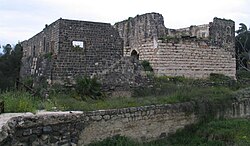

 was
was